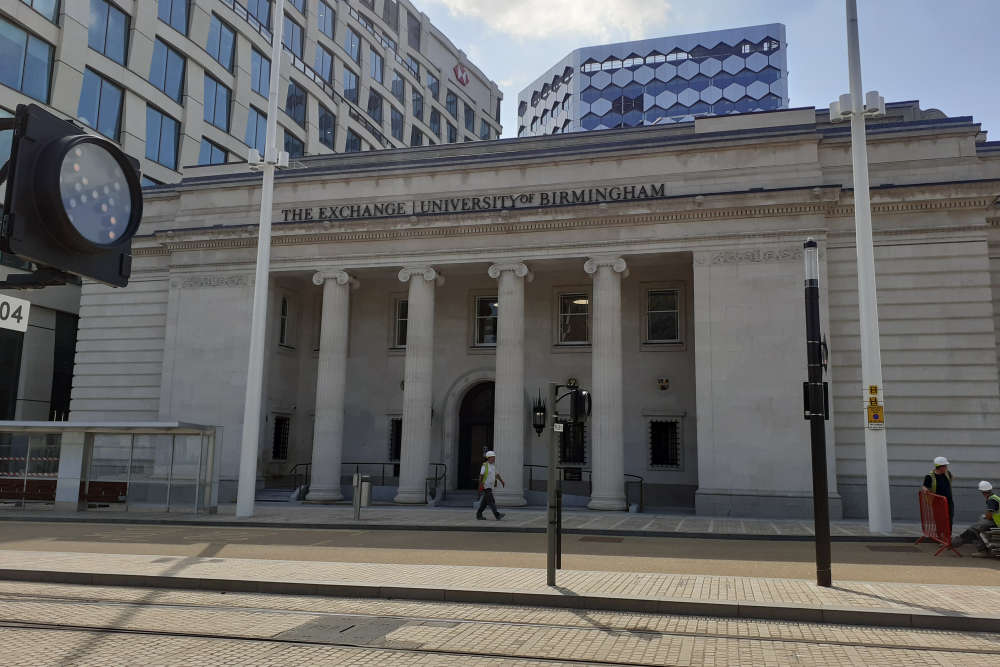
The University of Birmingham has been handed the keys to its new city centre location after completing a three-year renovation of the Grade II-listed former Municipal Bank.
The building, renamed The Exchange, is situated opposite Centenary Square and the Library of Birmingham, and was originally designed by architect T Cecil Howitt in the Monumental Classical architectural style. Its redevelopment will see it function as an engagement, knowledge and skills hub, providing an important opportunity for the University to enhance its role in Britain’s second city.
The formal north entrance from Broad Street has been restored to provide a strong civic presence facing onto Centenary Square, while a new glazed façade has been created to the south as part of the wider Arena Central scheme.
This stunning space faces onto a new public square known as Bank Court. Both entrances will welcome visitors to a facility that combines interactive public exhibitions , professional development, entrepreneurship and research, along with a new high quality catering offer, conference and commercial hire spaces.
With the building complete, plans are now underway to open the doors of The Exchange in September, with a formal public launch on 2 October 2021. Professor Tim Jones, Provost and Vice-Principal of the University of Birmingham, said:
“Today, we have the keys but work will continue to provide the city with a gateway into the University so that together we can make our city a better place to live, work and learn. The Exchange is part of our commitment to provide opportunities to create a place of curiosity, celebration, collaboration and change that will bring communities together.
“This important project reflects our commitment to civic engagement and our proud role in the region as a key partner and collaborator. What we have in store in the months and years ahead will be an opportunity to bring the best of the University to the city.”
 Credit: Beth Astington
Credit: Beth Astington
The Exchange aims to reinvigorate the city’s civic vision for the modern day by using the University’s role as an anchor institution to bring together multiple stakeholders to address the challenges of our time, and deliver inclusive growth for the region. The approach will bring the University’s research closer to people, enabling its work to inform and be informed by its audiences, providing dedicated facilities for collaboration across a number of areas:
- Opening up research. Public exhibitions alongside public and community engagement programmes will enable people from the city and wider region to get involved in the University’s work to solve the complex challenges of the 21 century
- Sharing data tools and fostering collaboration. The University is a rich source of data and intelligence about the city, the West Midlands and its economy. Providing access to this information at The Exchange will facilitate data sharing and partnerships that will help grow the regional economy and improve people’s quality of life
- New models of education delivery. The Exchange will provide free taster courses, short paid courses and micro-credentials, aimed at widening participation, professional development and/or building regional skills. A particular focus on leadership will encompass the private, public and third sectors and grow the capacity of community leaders. The Exchange will also provide a hub to support the development of entrepreneurial skills, helping to create the next generation of businesses
- New models of service delivery. The Exchange is a unique venue developed to create a welcoming and accessible visitor and user experience. Our aim is for The Exchange to be an inclusive space that attracts a range of different audiences and stakeholders to learn with and from each other.
Simon Courtney, Managing Director for Galliford Try Building West Midlands & South West, added:
“Despite the challenges of COVID-19 and the impact it has had on the way we had to adapt our working practices and processes, we are delighted to have completed on time this exciting regeneration project at the former Municipal Bank.
"Having been working at the Arena Central site next to the bank over the past few years, Galliford Try is proud to have redeveloped the old Bank and keep much of the fabulous features of the Grade II-listed building. It is now a first-class facility which is fit for purpose for a 21st century vibrant Birmingham and we are honoured to have continued our historical partnership with the University of Birmingham once again.”
The Birmingham Municipal Bank first opened after the First World War as a means for people of the city to rebuild their lives. The Bank's headquarters moved to several different locations in the city centre before eventually settling at Centenary Square. The building was opened on 27 November 1933 by Prince George. The facility, built by Neville Chamberlain, son of the University’s founder and first Chancellor, Joseph Chamberlain, will now be brought back into use for the people of Birmingham and provide a new public gateway to the University.














Comments
Add a comment